Ethernet in computer networks is wired technology we use to connect computers in a local area network (LAN), metropolitan area network (MAN), and wide area network (WAN). Bob Metcalfe & David Boggs invented Ethernet in 1976 at Xerox’s PARC (Palo Alto Research Centre). However, it was introduced for commercial use in 1980.
In 1983 “Ethernet” was standardized as “IEEE 802.3”, and we can use both terms interchangeably. The Ethernet has evolved over four generations to support higher bit rates, connecting more nodes over a longer distance, etc.
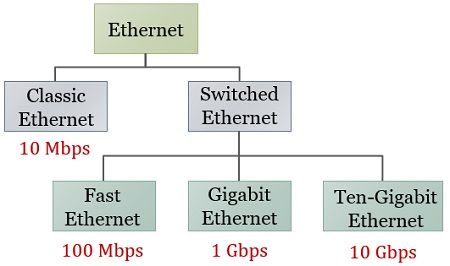
This section will discuss Ethernet in detail, along with its working types, cables, ports, advantages and disadvantages.
Content: Ethernet in Computer Networks
- Why is Ethernet Used?
- How Does Ethernet Works?
- Types of Ethernet
- Ethernet Cables
- Ethernet Port
- Difference Between Ethernet and WIFI
- Advantages and Disadvantages
Why is Ethernet Used?
We use Ethernet to connect computers to a local network area (LAN), Metropolitan area (MAN) or Wide Area Network (WAN). You might have seen Ethernet connecting all computers in an office building, college, school, etc.
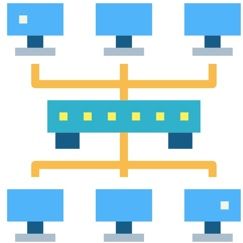
Ethernet remained in use due to its high speed, security, reliability, and compatibility.
How Does Ethernet Works?
Whenever a computer in the network wants to send information to another computer, the information is broken down into manageable frames or packets. These data packets have sufficient information (source address and destination address) to route through the network to reach their destination.
In the beginning, computers connected in a LAN shared a single channel. So, Ethernet protocols were built around the concept of CSMA/CA. I have discussed CSMA/CA in my previous content, “multiple access protocol”.
With CSMA/CD, the sender first senses the channel. If the channel is idle, it sends the packet. However, the scenario has changed now. The Ethernet currently operates in the full-duplex mode, which prevents collision.
Although Ethernet prevents collision, it does not deal with error control. Thus, it leaves the responsibility of error control to the upper layers.
Types of Ethernet in Computer
Based on the approach connecting computers in the network, we can categorize them into two types:
- Classical Ethernet
- Switched Ethernet
Classical Ethernet
Perceiving the success of Xerox Ethernet, companies like Intel, DEC and Xerox standardized the Ethernet with 10 Mbps speed as the DIX standard in 1978. Later in 1983, DIX became IEEE 802.3 standard.
Initially, the classic Ethernet used to be a single long cable used to connect all the computers in the building. It was popularly referred to as thick Ethernet. Thick Ethernet uses 500 meters of robust cable that would connect 50 computers at once.
The thick Ethernet further evolved into the thin Ethernet. A Thin Ethernet cable is flexible and makes connections to the computer using a BNC connector. Thin Ethernet was cheaper and easy to install, but its length was limited to 185 meters which could only connect 30 computers at once.
So, to form a larger network, multiple cables were connected with the help of repeaters.
Switched Ethernet
The classic Ethernet has to face problems such as cable breakage, loose connections, signal distortion etc. This led Ethernet to evolve away from a single long cable into a different kind of wiring pattern. So, we connect each computer with a single dedicated cable to a central hub.
Ultimately the hub was unable to handle the increasing load. As increasing load (connected computers) would saturate the network. So, the researchers again came up with a new wiring pattern that we refer to as switched Ethernet. A switch is similar to a hub. Each port of the switch connects it to a single computer using the cable.

How is Switch Different from Hub?
The hub broadcasts the data packet to all the computers connected. However, the switch forwards the data packet only to the intended computer. Ultimately switch prevents the wastage of available bandwidth.
Switched Ethernet has further evolved to fast Ethernet, gigabit Ethernet, and 10 gigabit Ethernet.
Fast Ethernet (100 Mbps)
IEEE standardized the fast Ethernet as IEEE 802.3u. The fast Ethernet can transmit data 10 times faster than standard Ethernet, i.e., at the speed of 100 Mbps. Fast Ethernet is compatible with Standard Ethernet.
Gigabit Ethernet (1 Gbps)
IEEE standardize the gigabit Ethernet as IEEE 802.3z. The gigabit Ethernet can transmit data at the speed of 1 Gbps. It is compatible with both Standard and Fast Ethernet.
Ten-Gigabit Ethernet (10 Gbps)
IEEE standardized the next evolved Ethernet, i.e. ten-gigabit Ethernet, as IEEE 802.3ae. The speed at which ten-gigabit Ethernet transmit is 10 Gbps. It is compatible with Standard, Fast, and Gigabit Ethernet.
Ethernet Cables
Just as the Ethernet evolved over the years, the ethernet cable has also evolved. Each cable has its unique feature and purpose.
Twisted Pair
The twisted pair is the oldest and most commonly used data transmission cable. It is a pair of insulated copper wires twisted around each other.
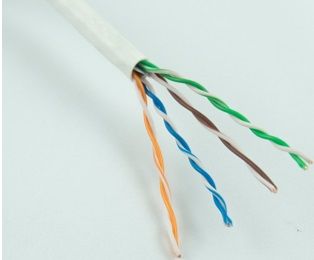
The varieties of twisted pair cables are:
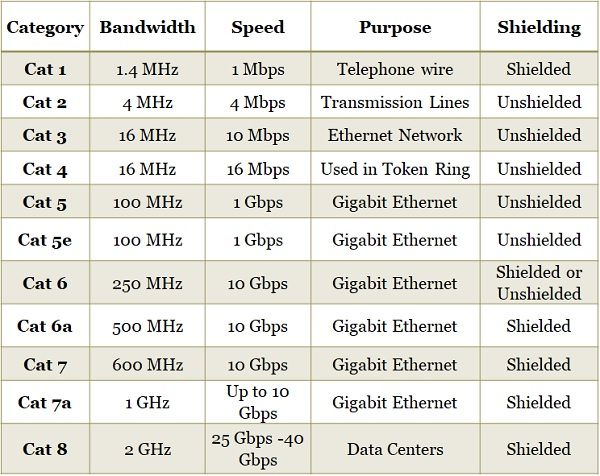
Coaxial Cable
Coaxial cable has better shielding, and it even offers greater bandwidth as compared to the unshielded twisted pair cable. It is a copper wire surrounded by the insulator, which is again encased in conducting braided mesh. The braided mesh is further covered with the plastic sheath.
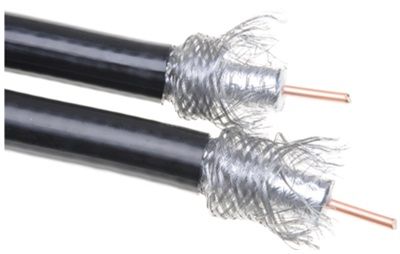
Earlier the coaxial cable was used for the telephone system over a longer distance. But they were replaced by fibre optics. However, we still use coaxial cable for TV and also for MAN.

Fiber Optic Cable
Fibre optic cable works with a light source, a transmission medium, and a detector. Here the transmission medium is an ultra-thin fibre or glass. It transmits information in the form of light.
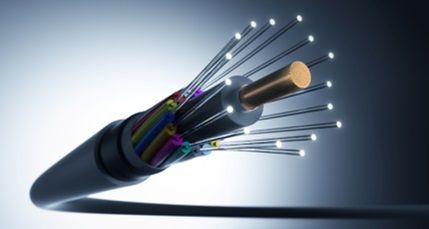
The light source is attached to the transmission medium at one end, and the detector is attached at the other. When light falls on the detector, it emits an electric signal.
The fibre optic cable can be of two types:
- Single-mode Fiber – Uses single light ray to transmit data.
- Multi-mode Fiber – Uses multiple light rays to transmit data.
The maximum speed that the fibre optic cable offering is 100 Gbps.
Ethernet Port
An Ethernet port is a port on a computer where we can plug in the Ethernet cable. It connects your computer to the LAN, MAN or WAN. The image below will show you what the Ethernet port looks like.
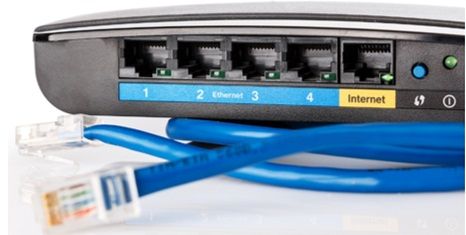
You can easily identify the Ethernet ports on the network devices such as your desktop computer, laptop, printers, and modems. Some devices, like routers, modem have several Ethernet ports to accommodate multiple devices on the network.
Earlier Ethernet cable was used to connect with the Ethernet port using BNC connectors. Still, as of now, it is the RJ-45 connector that connects the Ethernet cable to the Ethernet port.
Ethernet Vs WIFI
Ethernet provides a wired connection to the network or Internet. It restricts the mobility of its users. WiFi is an alternative for connecting a device to a network or the Internet.
| Basis for Comparison | Ethernet | WiFi |
|---|---|---|
| Technology | Wired technology | Wireless technology |
| Standard | IEEE 802.3 | IEEE 802.11 |
| Speed | faster | Comparatively slower |
| Security | Secure | Comparatively less secure |
| Reliable | Reliable for bandwidth-hungry applications | Less reliable |
| Mobility | Provides less mobility | Provides mobility to users |
Advantages and Disadvantages
Advantages
- Ethernet offers high-speed data transmission, i.e. up to 10 Gbps.
- All computers connected to the network using Ethernet have equal priority to access the network.
- The good quality Ethernet cable prevents signal degradation over a longer distance.
- Easy to administer and maintain.
Disadvantages
- Do not provide mobility to the user.
- Although the Ethernet cables have proper encasing to avoid any damage to the copper wire, still, they are vulnerable to temperature, physical force, and exposure to any chemical that can damage the cable.
So this is all about the Ethernet; we have discussed its invention and evolution over the years. Further, we have even discussed various Ethernet cable categories and learnt about its port. We have also discussed the advantages and disadvantages of Ethernet.

Sam Andrews says
I got a bit relieved after you mentioned that ethernet is a much safer method of getting a network connection. I wanna use my home office this weekend but its internet cable is so outdated. I guess I’m gonna have to find a contractor to make some replacements.